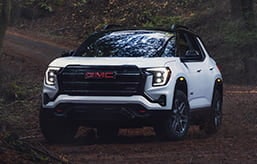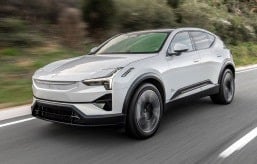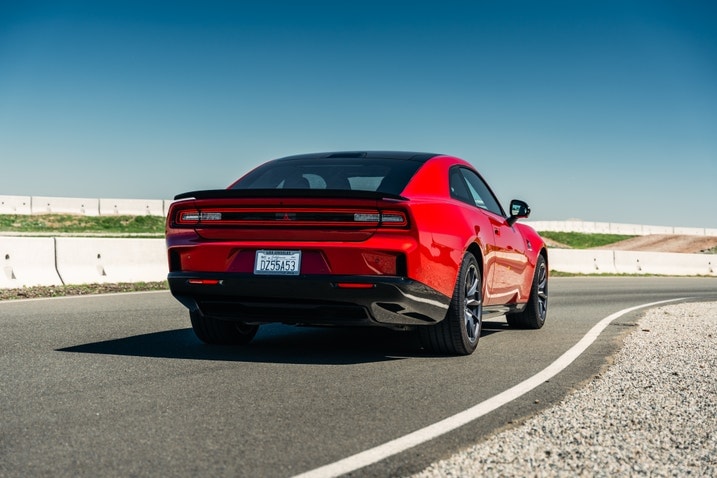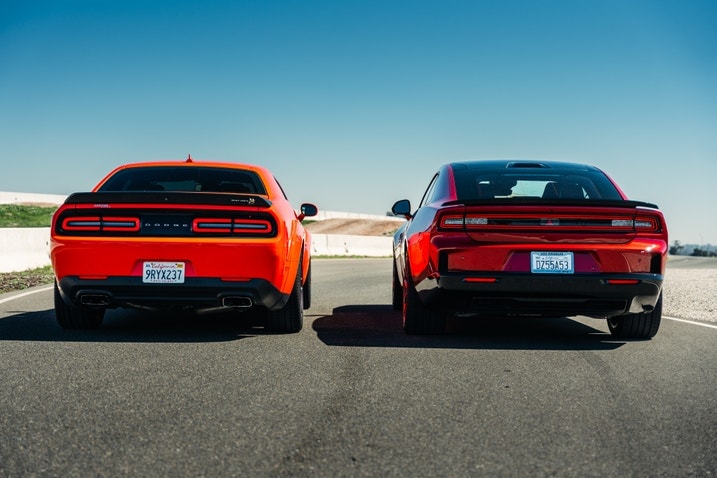- Two Scat Packs go head-to-head, one powered by a V8 and the other by electrons.
- The new all-electric (for now) Charger Daytona is replacing the gas-powered Challenger and Charger in Dodge's lineup.
- Even though the new car is quicker, is it more fun or satisfying to drive? We find out.
Dodge Challenger vs. Charger Daytona EV: Scat Pack Battle
I said the gas-powered Scat Pack was more fun. They said prove it.
It was just a few short weeks ago that we got our hands on the new electric Dodge Charger Daytona. And while I can't deny the new EV is quicker than any of the gas-powered Chargers or Challengers that came before it, I still found the new car lacking. The most damning thing about the new Charger Daytona is its lack of drama.
To prove that, I went back to our test track with the brand-new Charger Daytona Scat Pack we bought for our One-Year Road Test program, as well as a V8-powered Dodge Challenger Scat Pack. Are my memories of the gas car correct, or have I just been remembering it through Hemi-colored glasses?
Why a Scat Pack?
Sure, the Challenger Hellcat was the top dog, but the Scat Pack was the one we most often recommended. Its 6.4-liter V8 is plenty potent, and it's more affordable than the Hellcat. The sound is every bit as addicting too. And don't forget, there's a hotter version of the Charger Daytona on the way — likely called Banshee — which will be quicker, faster and more appropriate for Hellcat comparisons.
The Dodge Charger Daytona is already quicker from 0 to 60 mph than anything we've ever tested at our track with the supercharged Hellcat V8 under the hood. The best time we ever managed in a Hellcat-powered vehicle was 3.7 seconds to 60 mph in a Jeep Grand Cherokee Trackhawk, simply because its all-wheel-drive system helped it hook up and launch.
Scat Pack Battle: Charger Daytona vs. Challenger
Category | Dodge Challenger Scat Pack | Dodge Charger Daytona Scat Pack |
|---|---|---|
Engine/Motors | 6.4-liter Hemi V8 | Dual electric motors |
Transmission | 8-speed automatic | 1-speed direct drive |
Drive wheels | rear-wheel drive | all-wheel drive |
Power | 485 hp | 670 hp |
Torque | 475 lb-ft | 627 lb-ft |
Weight | 4,298 pounds | 5,974 pounds |
0-60 mph | 4.5 seconds | 3.5 seconds |
Quarter mile | 12.6 seconds @ 112.5 mph | 11.6 seconds @ 119.0 mph |
Lateral acceleration | 1.03 g | 1.01 g |
Braking 60-0 mph | 105 feet | 111 feet |
It's important to note that the numbers cited above were produced by a 2024 Charger Daytona Scat Pack that we got on loan (the car in the fully tested video), which had Goodyear Eagle F1 SuperCar tires (a $700 option). Our Charger Daytona that we brought to the track this time has the standard all-season tires instead, and predictably, those caused some of the performance numbers to drop:
- 0-60 mph: 3.7 seconds
- Quarter mile: 11.7 seconds @ 119.7 mph
- Lateral acceleration (200-foot skidpad): 0.91 g
- Braking 60-0 mph: 124 feet
Clarity is kindness
One of the biggest issues I have with the Charger Daytona is that the harder you drive it, the less enjoyable it is. If you start to make any demands beyond straight-line acceleration, those requests are met with uncertain results. Sometimes it's the Charger's ever-present understeer, or the fault of the traction control, which, even in Track mode, loves to cut power to one or more of the wheels midcorner and unsettle the car. Other times it's the brakes, which feel underpowered when combined with the all-season tires, and there's excessively long pedal travel. Then, when you finally do get the brakes to grab, the regenerative braking also kicks in, and it's not smooth. You have to wrestle this car to get it to stop without drama.
In the Charger Daytona, it really feels like front and rear motors aren't speaking to each other. While on our skidpad with the Charger Daytona, senior vehicle test editor Kurt Niebuhr noted that "[s]ometimes the front will push wide when you're on the accelerator; sometimes giving it power will make the rear end come around. You have to be very ginger (and slow) with your inputs." And that wide range of outcomes means that you're always approaching the car with a measure of reticence. Making matters worse, the steering is almost completely devoid of feedback. And while the Challenger isn't exactly amazing, its steering at least communicates more.
None of those issues are new; we've found them on both versions of the Charger Daytona we've tested. But swapping out the summer tires for the all-seasons made all of them worse, turning an already unruly coupe even harder to handle. It just feels sloppy all the time.
While the gas-powered Challenger Scat Pack is by no means a track car and not the easiest thing to get around our track at pace, it offers a much more enjoyable experience. It's surly, but it's predictable — and sounds so much better. Driving it is a bit like wrestling a bear, but you know what you're getting into from the start. The Charger Daytona is a bear that seems friendly and approachable at first, until it swings at you midcorner.
A win for the old ways
Between these two vehicles, even when you account for the vastly more modern interior and superior passenger room and cargo capacity of the Charger Daytona, I'm taking the Challenger home every time. That version of the Scat Pack is nicer to drive, whether you're on the track or on the road, and it's also got much better front seats with great bolstering. The front seats in the new car let you slide right out of them even when you aren't turning all that hard.
There are gas versions of the new Charger on the way. A turbocharged inline six-cylinder variant called Sixpack is on the way, and recent rumors are suggesting that a V8 engine could make its way into the car as well. But that won't save the Charger Daytona, which needs to have some of its rough edges smoothed out by the time the Banshee arrives. Otherwise I can already hear that Hellcat supercharger cackling its way to another victory for internal combustion, both for the old car and the new.
Photos by Ryan Greger






 by
by  edited by
edited by